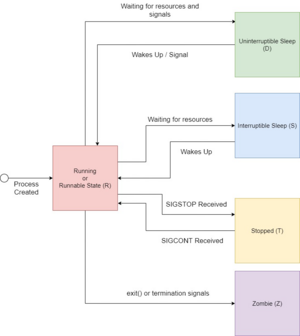Linux Process
Jump to navigation
Jump to search
Processes states
S Interruptible sleep (waiting for an event to complete)
D Uninterruptible sleep (usually IO)
R Running or runnable (on run queue)
T Stopped, either by a job control signal or because it is being traced.
W paging (not valid since the 2.6.xx kernel)
X dead (should never be seen)
Z Defunct ("zombie") process, terminated but not reaped by its parent.
<< high-priority (not nice to other users) N low-priority (nice to other users) L has pages locked into memory (for real-time and custom IO) s is a session leader l is multi-threaded (using CLONE_THREAD, like NPTL pthreads do) + is in the foreground process group
You cannot kill "D" state processes, even with SIGKILL or kill -9. As the name implies, they are uninterruptible. You can only clear them by rebooting the server or waiting for the I/O to respond.
How to know where a process was started and how it was started?
Most reliable way is to look at the /proc, /proc/<pid>/ directory where it keeps information like:[1]
cwd link to the current working directoryfd a dir with links to the open files (file descriptors)cmdline read it to see what command line was used to start the processenviron the environment variables for that processroot a link to what the process considers it's root dir (it will be / unless chrooted)
pstree -sp <PID> also give clearer relationship in tree view
systemctl status <PID>
